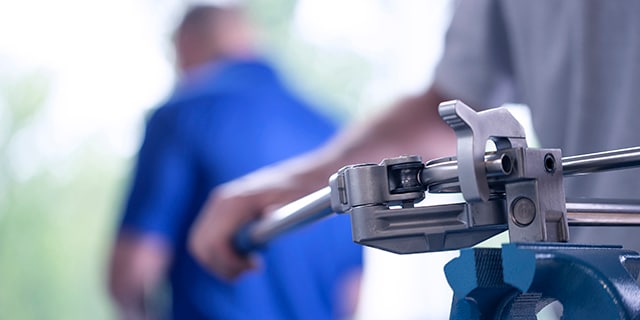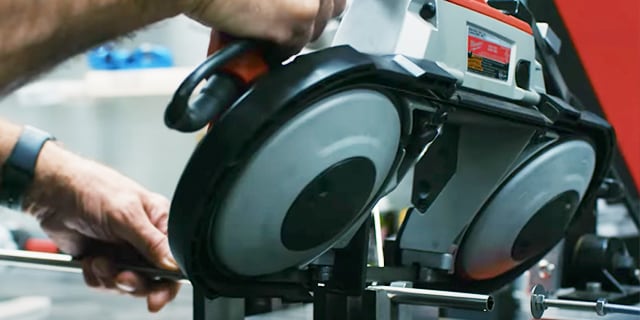How to Bend Tubing and When Bent Tubing is Advantageous

When to Bend Tubing—And How to Do It Right
Mike Gagel, Strategic Services Specialist, Swagelok Pittsburgh and Trainer, Advanced Tube Bending, Swagelok Company
Many decisions must be made during the design and assembly of a new fluid system or when replacing components in an existing one. One of the first decisions to make is whether the system should be built with stainless steel tubing or pipe.
While threaded pipe has historically been a reliable choice in fluid system applications, tubing is a beneficial alternative for a variety of reasons. One of those reasons is tubing’s easy bendability and routing capabilities, which can help operators achieve more intricate and efficient fluid system design with fewer connection points.
Tube vs. Pipe At-a-Glance
Bent tubing can provide some significant benefits versus traditional pipe in a variety of industrial fluid systems, including:
- Fewer connections. Fewer individual components means fewer potential leak points, which can improve efficiency and reduce spills and fugitive emissions.
- Time savings. Not only do tubing systems offer easier installation, but tube bends can save operators time by eliminating the need to cut, deburr, and install a new fitting for every simple directional change.
- Less turbulence. Bends allow fluids to flow more easily than through a series of multiple fittings.
- Smaller footprint. Tube bends and low-profile tubing allow a more compact system footprint and easier access to nearby equipment for maintenance.
Best Practices in Tube Bending
To maximize the benefits tube bending offers, it is important to be sure you understand how to identify where tube bends are most applicable in your systems, best practices for making high-quality bends, and how to use the right equipment. Here are considerations for deciding when to bend tubing and how to help ensure system safety and efficiency.
1.) Determine whether tubing will be advantageous over pipe. There are a few considerations to be made here. To make a desired run using pipe, the pipe must be cut, deburred, and threaded. All male threads must be wrapped with a PTFE tape or covered with a sealant. The pipe fittings are then tightened with a wrench. A well-built system can provide high reliability, but the assembly process can take up significant labor time, especially for a complex system application. Additionally, each new introduced fitting connection is a potential leak point even if it has been put together by a skilled assembler—and added leak points can lead to an increase in emissions.
This is where tubing can provide some benefits. It must also be cut and deburred, but most directional changes can be accomplished with a bend instead of a new fitting. A single bent tube can accomplish several directional changes as opposed to pipe where many different runs and fitting connections would be required. Additionally, compared to a pipe elbow, a tubing bend creates less turbulence as system media flows through it. Tubing is also lighter weight than pipe and will not require as many supplementary supports.
2.) Determine how you will perform your directional changes. Directional changes will be accomplished by bends, or by connecting separate lengths of tubing with high-quality tube fittings. Bends are applicable for many directional changes—but your choice between a bend or a fitting largely depends on the situation.

Bends are not applicable everywhere. A minimum length of tubing is required to bend yet still allow the tube to be installed in the tube fitting safely. If you are dealing with several short lengths of tubing, it is more appropriate to use fitting connections for a directional change. Additionally, if a certain required directional change will require a more complex bend than you are comfortable making, it may be beneficial to use a fitting. This situation illustrates why following best practices is so important to creating safe, efficient, and cost-effective systems with bent tubing.
3.) Make sure you have the right skills to perform tube bending. Tube bending is as much an art as it is a skill, requiring technicians to think in three dimensions to turn designs on paper into physical systems.
Operators must also know how to use a tube bender and other equipment to complete accurate, quality bends. There are two common pieces of equipment that are applicable for many bending applications: a hand tube bender and a benchtop tube bender. In the following videos, you can find practical instruction on how to use each type of tube bender:
How to use a hand tube bender:
In this video, learn how to use a hand tube bender to accurately and efficiently make 90° and 180° bends in tubing. Swagelok® hand tube benders provide consistent, high-quality bends in tubing made from most materials used with Swagelok tube fittings.
How to use a benchtop tube bender:
In this step-by-step instructional video, learn how to use the Swagelok® bench top tube bender to produce accurate, repeatable, high-quality bends in tubing made from most materials.
Following the best practices established in these videos can help technicians avoid a variety of common defects that can compromise the integrity of even the simplest bends, resulting in a waste of time, labor, and money.
Training courses can be invaluable for equipping technicians with the practical knowledge needed to create safe, efficient fluid systems with bent tubing. This is why Swagelok has developed training courses for tube bending—ranging from the essentials to more advanced techniques—to help fluid system professionals establish practical skills they can apply in their facilities. If you are interested in learning more about how we can help you enhance your tube bending abilities, contact our team today.
Related Articles

The Three T’s to Achieve an Intricate System of Tubing
Learn how the three T’s to using a hand tube bender can help you achieve an intricate system of tubing with fewer leak points and efficient flow.

How to Avoid System Leaks: The Importance of Proper Tube Preparation
A successful tube fitting depends on many criteria, but one of the most important is proper tube preparation before installation. Learn to avoid costly or dangerous leaks by avoiding damaged, burred, or improperly cut tubes.

How Fluid System Fabrication Can Alleviate Resource Constraints
There are several common fluid systems that successful plant operations depend on, and choosing the right fabrication provider can be highly beneficial if you’re short on resources.

